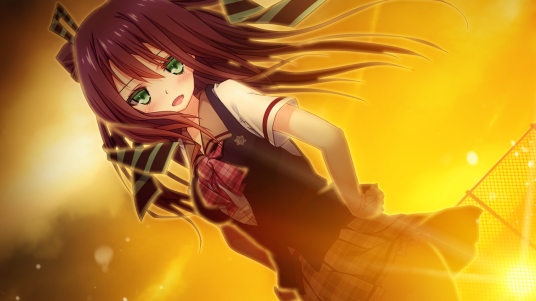So as 2017 comes to a close I’ve decided to put some effort into writing (not editing said writing though) about the eroge I really enjoyed from this year.
I’ve picked a couple of games and given them some arbitrary headings with a quick little blurb before the reviews and recommendations. The reviews are written spoiler free since this is a highlight so they don’t go particularly in-depth. I’ve also clearly marked the individual games’ sections with screenshots and the name of the game as big blue links so if there’s a game you don’t want to read my ramblings on you can easily skip it and remain pure.
So with all of that out of the way.
LET’S GO!

Highlighting Convention & Controversy
There’s a kind of duality in fiction between conventional writing and experimental writing. This is something that’s especially present in eroge since it’s a medium that has a very well established general road to take with tropes and archetypes but being a sub-cultural and pornographic medium also lets it explore a lot of niches.
The duality creates a question of balance since certain structures are tested and proven to work but there’s also a desire to create something new. So when does something cross the line of being too experimental and ending up being incomprehensible, and when does something cross the line and become just like everything else you’ve read?
I usually appreciate coherency, enjoyment and consistency over being shocked and surprised but there is a certain controversial aspect to experimental works I find very appealing. The idea of an experimental work is usually to challenge the viewer/reader and I’ve had several experiences where these challenges felt undeserved and shallow. In contrast I’ve also read works that felt pointless since they just went through the motions without their own personality or purpose.
In this part I’ll be highlighting two games that I think are relevant to this duality. The first one being Tsukikage No Simulacre, a conventionally very good eroge. The second one is ChronoBox which posed a challenge to me that left a lasting impression.
***
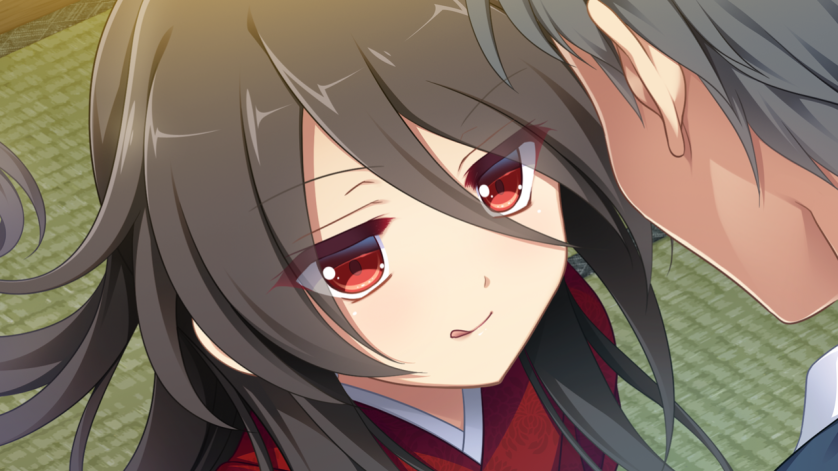
Tsukikage No Simulacre is a short game produced by Applique with a full release in January 2017. It’s a shorter game with some similarities to the earlier Applique work Tasogare No Sinsemilla (Beyond just the similar titles). The game is written by Kiduki a writer I familiarised myself with during 2017 who quickly became a personal favourite.
Tsukikage is a polished experience in every aspect. From the writing, to the art, the music and the sound design, it’s a work that shows clear signs of competent craftsmanship. The fact that the game is shorter in length also brings a focus with it that ties it all together into a finely tuned machine.
Tsukikage plays competently and confidently with the tropes associated with the mystery genre, like the mansion and the haunted doll, and while never making a grand statement out of subverting them it uses them to tell its own pretty different story. Despite having routes the game is linear not simply because you have to read the routes in order but because the routes flow into each other. The game doesn’t repeat information you already know when you read a new route and it doesn’t lower the stakes or pacing. Basically there’s never any real reset which turns the whole experience into a single, linear flow.
The set piece of the game and what every aspect of it revolves around is the haunted doll Kurenai. A horror trope, an eroge heroine, a mystery, and yet an empathetic and interesting character. Despite being the spooky monster of the mansion, or rather partially because of this, the reader is charmed by her from her first appearance. This appearance is one of the game’s many promises and it delivers on all of them which is why it’s such a satisfying read. The final route of the game picks up the pace a lot and goes into full deliveryman mode. The game knows what you as an eroge reader and as a mystery reader expect and all the set ups lead to payoffs.
Tsukikage like all Kiduki games is a very thematic work and some of these themes are shared by all Kiduki games. Tsukikage is definitely the game that manages to deliver them with the most efficiency and impact. The ideas that are explored are all relevant to the main point of the game and they all tie into each other like a spider’s web (the game has spiders in it so I had to sorry).
I should also mention that the game delivers on the bad endings whether you like them bloody emotional or both it’s got them.
I don’t really believe there exists anything like universal appeal and I think putting weight on craftsmanship in art is overvalued but Tsukikage gets a blanket “would recommend” from me to anyone who enjoys eroge. It’s short, it’s well produced, it has juicy doll sex, bleeding dongs, I mean come on how could I not recommend it?
It does make some homages to Tasogare No Sinsemilla and does share a bit more with it than other Applique and Kiduki games so I would like to recommend doing Tasogare first but it’s a harder game to recommend since it’s a lot less focused and polished than Tsukikage.
In short: Good game would recommend.
***
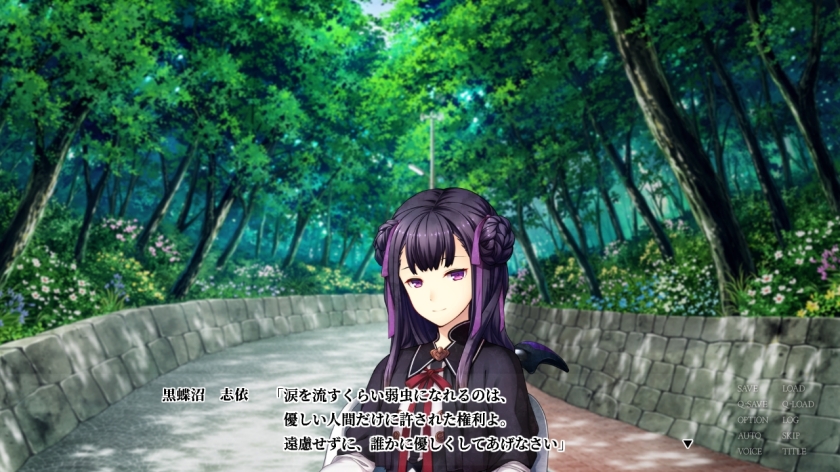
ChronoBox is the debut title of No Brand and the third game written and planned by Sakuraba Maruo who wrote Dasaku which I rambled on about in an earlier blogpost. The game released in May 2017 and had a series of trials that started in October 2016. I mention the trials since they’re important to check out and is where my adventure with the game began although months after they were released.
I’ll just start this section off by mentioning that ChronoBox is one of my all time favourite eroge so the ramblings may get especially severe.
In the part before this I talked about Tsukikage’s conventional quality and how it’s a game that invites you to enjoy it. The reason why I decided to let these two bangers share one headline is that ChronoBox kind of does the opposite to that. ChronoBox challenges you to to find an angle that allows you to like the game. I worked hard in private messages on discord in the middle of the night and conversations with myself in the shower to put together an interpretation of ChronoBox that didn’t make me angry.
You see ChronoBox is a mystery game but like Tsukikage there’s more to it. Very much unlike Tsukikage the game is not a finely tuned and polished coherent narrative. The true mystery aspect of ChronoBox is born from the fact that the game simply presents you with all these perspectives and then ask you to kind of make out of them what you will. The game has a super solid escalation, the mystery set up and pay off is wonderful because you see the actual mystery of ChronoBox isn’t in the physical mystery of finding out what’s going on since the game is nice and competent enough to actually contain a satisfying mystery. The real mystery of ChronoBox is what the point of it all is? What is the game saying? The characters in ChronoBox are very opinionated but the game itself isn’t at all which leads to conflicting perspectives. This makes the game extremely fun to discuss and form an interpretation of but it also gives the reader a lot of work.
There are several reasons as to why I was alright with ChronoBox challenging me to enjoy it. First of all the game is just straight up a ton of fun outside of the digging through egs reviews for people who noticed the same detail you did to make sure you’re not insane. Sakuraba Maruo hasn’t gotten many projects of their own yet but I really enjoy their style. Maruo’s narration is full of character and while their dialogue easily devolves into nukige nonsense there are consistent comedic chops and some very aware eroge-feel. I’ve never been a stickler for realism and instead value flow and character even if they end up in extremes, and Maruo is kind of a master of the extremes.
The second reason why the challenge felt deserved is that the more I dug into the game the more of value I found without having to make any big stretches (of course making big stretches was also rather fun). The game gives you feedback when you ask questions and since I consider art a conversation between a work and the person experiencing it ChronoBox came off as very personal. My very personal conversation with the game also makes it quite clear that it’s a divisive work.
There are some strong aspects to the game that are independent of this divisiveness though. Despite No Brand being a brand new studio the game is very well produced and has some impressive musical and visual qualities and while the voice cast isn’t on the levels of something like Hoshi Koi the performances are absolutely great, especially for the awful scenes. The trials are another really impressive part of the production so definitely play them if you want to check out the game.
So would I recommend ChronoBox despite thinking it’s divisive? Yes. Even if you end up hating it I’ll feel good about it.
Science, Fiction, and Other Memes
There’s a type of game I’ve come to refer to as a meme game, or memege for short, in casual speak (and by that I mean written conversations of course). Only recently did I have the realisation that the term could be taken as derogatory. My own personal use has always been with an implied excitement and endearment but discrediting a game by calling it nothing more than a meme leads to some counterproductive discourse I’d like to avoid. Calling something you enjoyed a “meme” just feels like a way to avoid having your opinion challenged since you hide it behind sarcasm. I don’t want memege to be synonymous with guilty pleasure since I don’t think there’s any shame in enjoying any work.
This is why I will refrain from using the word meme in the rest of this section and write about my genuine excitement and enjoyment of two titles from 2017: Hoshi Koi Twinkle and Hikari No Umi No Apeiria.
***
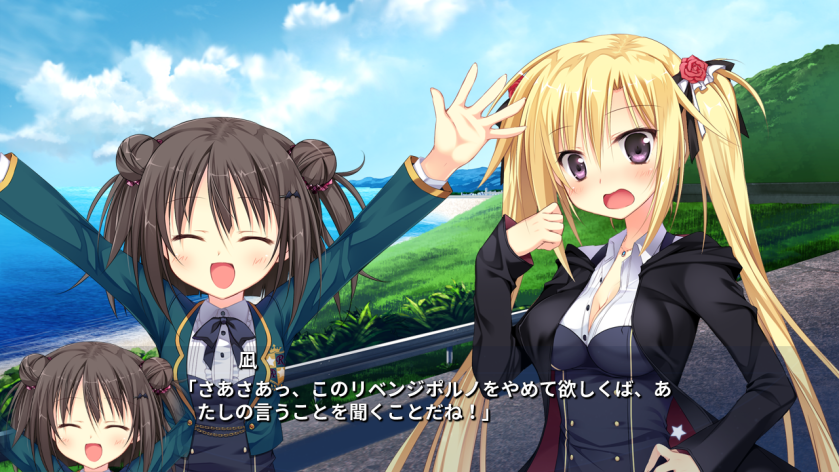
Hoshi Koi Twinkle is the debut title of the studio Cabbage Soft written by Nakahiro, a writer I was familiar with before thanks to AstralAir from Favorite.
Hoshi Koi was released in January 2017 but I ended up reading it in April after a pretty bad reading slump. Having not read anything for a couple of weeks my expectations had basically been completely reset so I went into Hoshi Koi easily impressionable hoping for it to rekindle my excitement for the medium. What I was met with was a pure childlike wonder that made it impossible to stay cynical.
Hoshi Koi is a game that managed to walk the dangerous tightrope of naive art without falter. Every aspect of the game oozes with innocent ignorance in a way that feels genuine while also completely intentional.
The game opens up with a pretty classic scene. A brother and a sister on a train on their way to the town that will become the stage for this preschool play. Already in this opening scene does the game show its hand as the siblings somehow end up getting off at the wrong station. This is the game giving you a taste of the incompetence you’re about to experience through out the game. It eases you into it so when you find out the younger sister can’t even dress herself you don’t ask if she’s suffering from some kind of disability. In the universe of Hoshi Koi being unable to dress yourself is a common occurrence and the reason for why is twofold. First off it ties into the naivety, the town Hoshi Koi plays out in is basically Neverland where no one truly ever grows up. The second reason is that Hoshi Koi is an extremely horny game. Like I know pornographic games being horny should be a given but holy shit Hoshi Koi. It’s almost impossible to take a screenshot without including half a nipple or some delicately placed sweat. Childlike naivety and horniness sounds like a recipe for absolute disaster but Hoshi Koi manages to get the nuance right. Rather than being a horny game about childlike characters which is something I’d never highlight in a blog it’s an eroge told with the naivety of a child. The characters don’t really act like children they act like what a child might imagine someone in their late teens would act like.
The same thing also applies to the story. The drama is all based in things that actual adults wouldn’t really put much weight on and the solutions are all impossibly grand and absurd. This leads to the game being about rather small silly things being blown up to extreme proportions which is crystallized in the grand route. A child imagining going to their friend’s house down the street when their parents are away like an epic adventure, that’s how a lot of Hoshi Koi read to me.
The game can easily come off as extremely stupid but there’s something very appealing in having a story so void of bitterness. A much better comparison than all these involving actual childhood experiences is being an adult going on a children’s ride at an amusement park.
Hoshi Koi Twinkle was the perfect game to get me out of my slump since it made me remember that it’s fine to be an idiot. If you’re going to overthink things at least do it in fantastical grand ways.
Hoshi Koi Twinkle is a pretty easy recommendation if you’re not the kind of person who complains about characters being stupid and you don’t mind extremely overt horniness out of nowhere. It’s pretty short and sweet and you figure out pretty quickly if you’re going to be in on the ride.
Oh I should also mention that the voice cast is absolutely amazing, which is honestly way more important than all the stuff I’ve rambled on about.
***
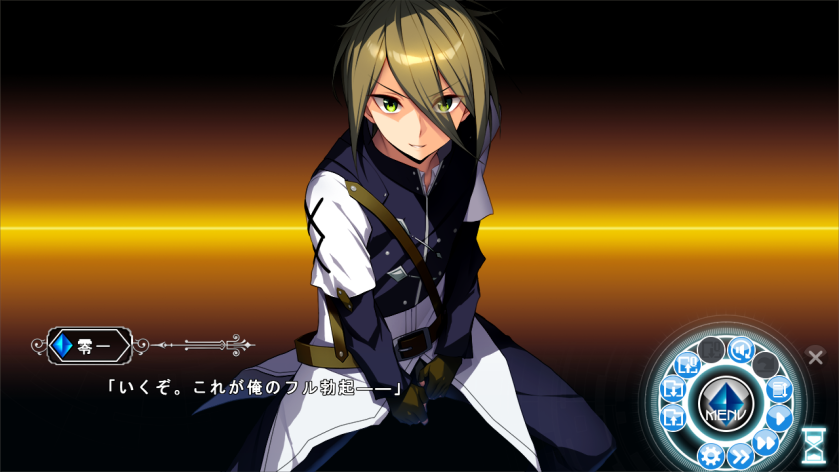
Hikari No Umi No Apeiria was released in July 2017. It’s the fourth game from Silky’s Plus and the first one from their sub-brand Dolce. It marks a departure from Silky’s Plus’ earlier focus on mystery stories and is instead a humorous science fiction work. The writer is Hanno Shuusei and Apeiria remains the only work of theirs I’ve read.
Apeiria opens up with a voiced scene of the protagonist masturbating in the park with the goal of shooting a load 420 centimeters. Like with Hoshi Koi the game gives you a face full from the very start. As opposed to Hoshi Koi though the horniness of Apeiria is expressed through dick jokes and has more of a dirty old man twist to it. Apeiria’s love for perverted jokes makes a lot of sense when you look at what the game is and where it takes inspiration from.
At one point I described Apeiria as a 闇鍋 (Yaminabe, a kind of stew prepared from random ingredients in the dark by members of a party) of sci-fi but there are definitely some nicer ways of putting it. Apeiria is a love letter to scifi pop-culture in all its forms. it references everything from novels to films and anime. While it parodies the genre it does so respectfully clearly coming from a place of appreciation and while it pulls from a lot of sources it holds up as a pop-cultural sci-fi work on its own. The inspiration for a lot of the perverted jokes becomes pretty clear when the protagonist gains a power that’s basically a light-saber penis. Apeiria manages to be way less derivative than some of its inspirations however. It competently explores actual sci-fi themes mixed into the stew of references and dick jokes.
What makes Apeiria really stand out in a scene full of aspiring quantum physics wikipedia summaries is that it’s not afraid to go into logical extremes. Apeiria is well versed in the myriad tropes associated with sci-fi and instead of using them as a foundation to build on it constructs a beautiful Time Cube out of them featuring everything you know and love/hate about sci-fi like: Twists upon twists and explanatory graphs so big they don’t fit on the screen and have to scroll.
Despite being a pretty meta work the bar of entry for Apeiria is very low. Any eroge reader will be familiar with the tropes it plays with since they ooze through so much of the medium and even someone not too well versed in eroge specifically can appreciate the nods to western sci-fi novels and films.
Aperia’s weakness lies in the cast since other than the titular Apeiria and the objectively best character (character polls don’t lie) Thinker they don’t really portray any typical sci-fi stereotypes nor do they really stand on their own. Considering the places the game goes this is a pretty minor issue however.
A funny side detail that tells a lot about the game before I go into my recommendation comments: The protagonist is partially voiced by Furukawa Tetsuto and the scenes they chose to voice pretty much all feature him masturbating.
If you’re the kind of person who posts very angry screenshots on twitter of eroge characters mentioning Schrödinger’s cat then Apeiria is most definitely not for you. If you enjoy sci-fi and laugh at dick jokes, basically if you’re mentally an old man, Apeiria is probably a pretty safe recommendation though. The production is of course great since it’s Silky’s Plus and while there’s a bit of a dip during the heroine routes the game is a pretty wild ride throughout.
How to Follow Up on a Joke
I’ve had a fundamental dislike for serials in basically all their forms for most of my pseudo-adult life. I used to be big into manga but stuck to single volume works or anthologies I could stop reading at any chapter. I often find myself using the “unfinished story” argument when I criticise episodic works and while I believe there is some merit to that it doesn’t explain my dislike for sequels since by definition they’re a work building upon a finished story.
It wasn’t until a tweet chain from my favourite eroge writer Kazuki Fumi and one tweet about a potential fandisk in particular that I was able to put two and two together. My issue with expanding works isn’t so much about something being incomplete, it’s about more being added than what’s needed. Brevity is the soul of wit after all and I’m a pretty adamant subscriber to the idea that less is more when it comes to most stories. Adding more “content” only dilutes and dulls the point of the original and by repeating the point you’re beating a horse that you killed yourself. Going too far away from the source instead makes you wonder why the work even needed to be a sequel when it would have been fine on its own.
Because of these difficulties i associate with sequels I’ve decided to highlight one I think did a great job of avoiding the easy mistakes.
***
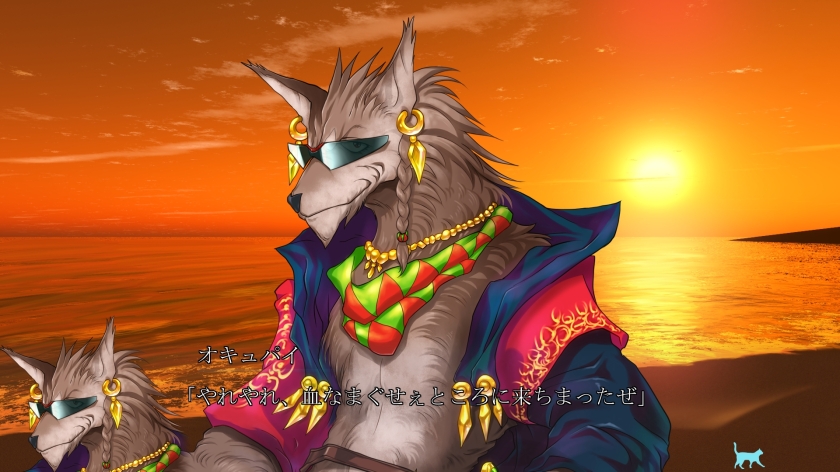
Nora To Oujo To Noraneko Heart 2 or just Noratoto 2 for short is the sequel to the game of the same name (well minus the 2 of course) from February 2016 developed by Harukaze and written by Hato. Noratoto 2 was released in October 2017 and I read it on the day of since I was quite a fan of the original despite its blatant flaws like an unfinished route and tonally dissonant drama.
Noratoto 2 picks off after the common route of the original game so like with a lot of eroge follow-up works it isn’t really a direct sequel. Even though the original did have an ending that felt like the grand final it was still very much a comedic work where the plot mostly existed to feed into the jokes or characters.
From a look at films it would appear that the only genre easier to make sequels for other than comedy is horror but as mentioned earlier I’m a quality over quantity kind of guy and ease of producing does not mean ease of making something worthwhile. With comedy the simple trick is to just repeat the same jokes but change the stage for them. You don’t even need to mix it up, just attach a “Christmas” or “European” at the start of the title and as long as people laugh they’ll consider it a good comedy since that’s the point of a comedy right?
I was completely ready for Noratoto 2 to be snow flavoured Noratoto so I could get some good laughs out of the repeated jokes I liked from the original and then go on discord and talk shit about sequels with myself in front of people.
Instead the game used the setting and tone established in the original as a stepping stone to explore new areas and topics and really breathe life into the world.
The original focused on the cast and while the routes in noratoto 2 are also definitely driven by the characters’ personal problems the game as a whole shifts the focus to the setting to explore the city, the underworld and the background cast.
It’s the same stage as before but it’s now in the spotlight. The main cast from the original game are now side characters which gives them time to just act in their natural habitat and you get to see their normal routines rather than their exaggerated drama. The game adds a ton of new locations and backgrounds (although some were kind of iffy 3DCG) to create this feeling of geography, like this town is an actual place and not just a back drop. The side cast of the original also of course get their time in the spotlight through the routes but on top of that an enormous cast of random people and furries (Oh boy the furries) is thrown into the mix.
Noratoto 2 takes the opposite route of the usual comedy sequel in that instead of just repeating itself in a new context it shines a new light on the old context.
As with the original the game is very well produced and directed. Even though I had personal issues with some of the ideas portrayed the events and progression had a pacing more coherent than most routes of the original. Lucia’s story in particular had a masterful escalation to it.
In the end Noratoto 2 stands on its own and has its own issues and strengths independent of the original. It manages to completely dodge being redundant while still staying true to the fun absurdity of the original and takes the trophy as my favourite sequel of 2017 (Did I even read any other ones? Oh well).
Anyone who liked Noratoto should read it and while it’s possible to like it if you disliked the original it’s kind of hard to recommend. Strongly recommended to any aspiring furlord, the game probably has as many dog-boys at it has human characters. (No routes or sex scenes for them though we’ll have to wait for the Okyupai fandisk for that. Again: Character polls don’t lie, 12th place baby).
Railing Back Your Expectations
Time to put on some Simple Plan bangers it’s whining time.
I always prefer taking a positive and optimistic stance and this post is intended as a highlight but sometimes you have to highlight issues.
I mentioned in “How to Follow Up on a Joke” above that I have an issue with unfinished works in reference to episodic works and serials but sometimes you end up with a standalone story that just sort of ends. Old Liar-soft titles are kind of notorious for doing this but I figured that in this golden age of early access and piecemeal DLC Frankensteins we’d be smarter than just releasing an unfinished mess at full price and instead slap an episodic or partial label on it to cover our asses.
I’ve read quite a few games from new brands this year and they’ve all delivered above my expectations in terms of production so I guess it’d take a hardened veteran to have the stone cold balls to denial play 75% of a game away from their audience.
***
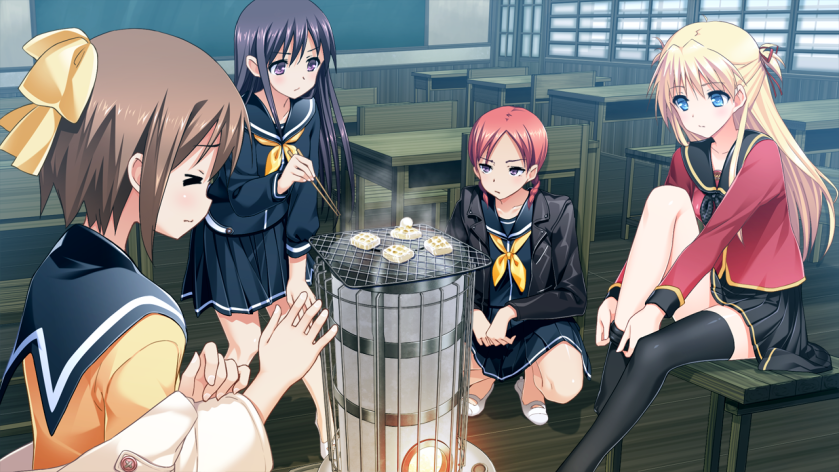
Omokage Railback, released September 2017. Shares characters with Sakura Sakura from 2009. Developed by Hiqo Soft. Preceded by a short unvoiced prologue.
After months if not years of delays the game was released unfinished.
Despite the events of the game being hinted at in a game from 8 years ago it manages to have a common route only barely longer than the trial and 10 minute routes consisting of nothing but sex scenes. To add insult to injury the game has an after story mode showing off assets for a whole winter episode that never happens. I have no idea what happened in production but it doesn’t matter since the end result is a product that will probably never stop frustrating me, that was sold as if it were a finished product.
My expectations for Omokage Railback were high. The prologue was wonderful (better than the “full” game), I enjoyed Sakura Sakura, the trial was fun although very short. When reviews started pouring in confused about the games length I shrugged them off, I like short games after all. I believe this is the stage they call “denial” which slowly but surely evolved into anger as I realised that this was it.
I was very into the cast of Omokage Railback partially thanks to the prologue but also on the merits of the game itself. Looking at the image I started this section with I think about what could have been but then I remember the image is from a short bonus scene detached from the “main” game. All the strongest parts of the game were just ephemeral unrelated scenes giving me a peek into the life of these characters and when I look at them isolated I see something beautiful but they all added up to nothing. This is why I decided to highlight Omokage Railback, since the frustration it has caused is impressive. I hate judging games for what they aren’t and speaking about “potential” since it’s irrelevant. I don’t subscribe to the idea of a Platonic ideal through world where Omokage Railback isn’t a train-wreck so talking about what it could have done or could have been is just a less productive form of fan-fiction. That being said though I’m only human so I’m pissed of that I can’t enjoy Omokage Railback and that I think it’s an undeniably terrible game despite falling in love with it at the start.
Don’t read Omokage Railback even out of morbid curiosity. I’m not against reading terrible eroge, hell I’m a huge fan of watching bad films and it’s not like my time could be spent on anything more important other than rambling blogposts like this one. Omokage Railback isn’t bad in a way that anyone other than the ultimate edging master would find enjoyable. Despite being short (actually I guess in this game is partially because of that huh…) I would never recommend Omokage Railback to anyone under any circumstance. It’s not worth it to shit on. It’s not worth it for the porn (they even forgot adding music to one of the after story sex scenes). It’s not worth it for the fun cast since seeing them go nowhere and having the game pretend that that’s their stories and endings is just insulting.
The moral of the story is to never trust anyone, never commit to anything and always protect your fragile heart with a wall of cynicism and sarcasm.
Or you know just don’t read Omokage Railback.
Low Lights
You want me to give you a testimony about these games?
And how good they’ve been to me?
I don’t know what to tell you about them.
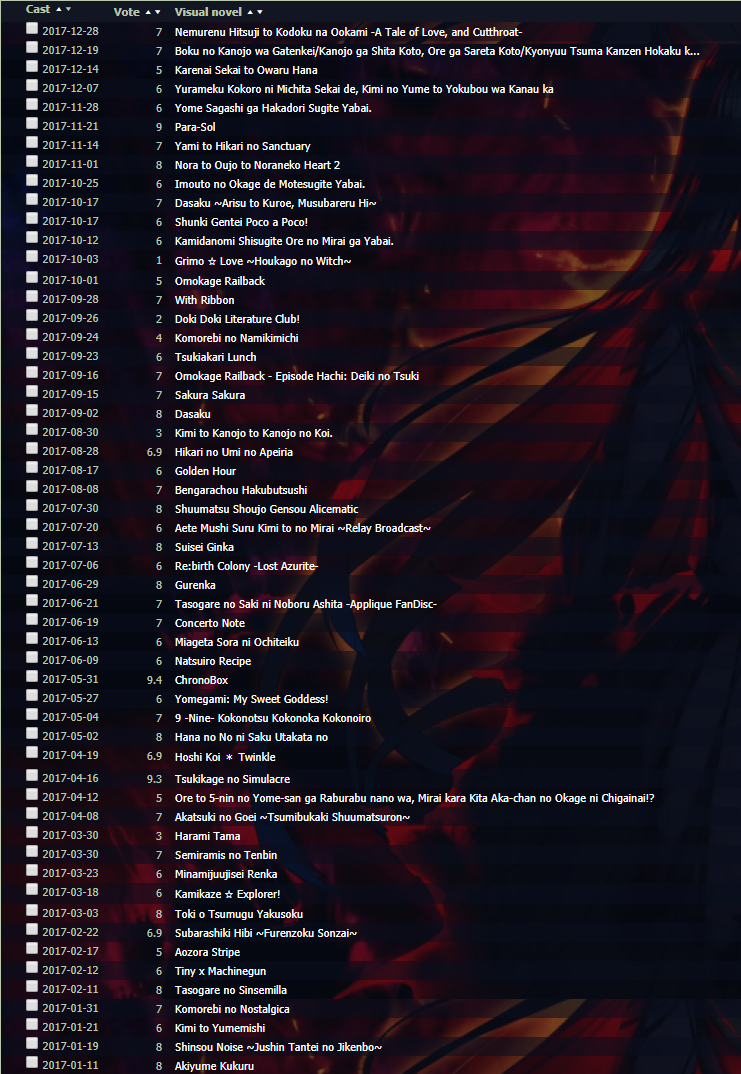
Well as it turns out I read a whole lot more games in 2017 so let’s go over the 9 other new releases I read and didn’t highlight and mention why they didn’t get their time in the spotlight.
9 -Nine- Kokonotsu kokonoka Kokonoiro: Episodic game, can’t really judge it until more episodes come out.
Golden hour: The trial covered the best parts of the game. The drama in the route ended up not mattering and the ending felt extremely rushed.
Omokage Railback – Episode Hachi: Deiki No Tsuki: The Omokage Railback prologue I mentioned in the Omokage review part. It was great but the prologue to an unfinished game.
Doki Doki Literature club: I just don’t care to write anything about this.
Kamidanomi Shisugite Ore No Mirai Ga Yabai: The yabai series is all kind of the same and I mostly just read it for the art and voice casts. Maybe some day Hulotte will make another game as fun as With Ribbon again.
Yami To Hikari No Sanctuary: A Kiduki games with side writer routes. Way too much filler especially in the side routes.
YuraUka (abbreviated title because come on now): Way too derivative and never lead up to anything.
Nemurenu Hitsuji To Kodoku Na Ookami: I finished it the moment before finishing up this review so I didn’t really have the time to stew on it. The game ended up with too many loose ends and the explicit content was way too much.
Suisei Ginka: Oh what this was a 2017 release? Oh no I actually really liked this game and forgot to include a headline for it since I thought it was a 2016 jam. Stop the presses I guess I’m doing a quick final highlight here we go!
Suisei Ginka is a cool game and I totally didn’t forget about it
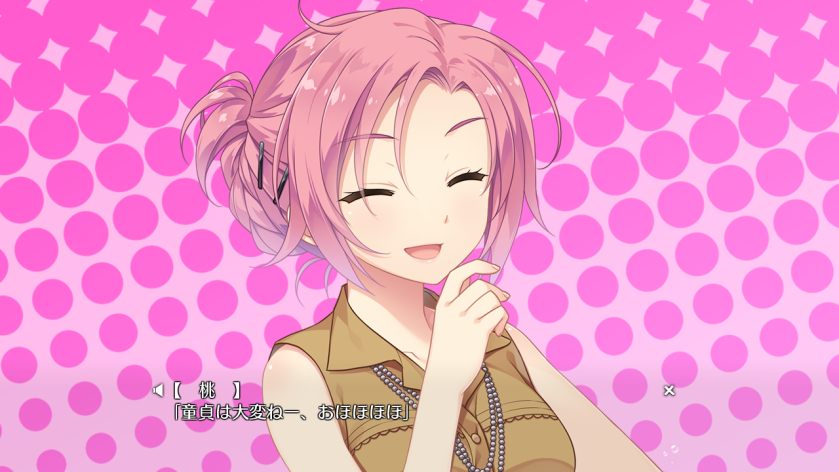
Suisei Ginka is a game produced by Akatsuki Works but the whole thing just scream Applique production which is to say it’s very good. The game was directed by Noriyuki, written by Morisaki Ryouto, and released in February.
Suisei Ginka was a very happy surprise for me since the previous game I read by Morisaki Ryouto, Re:birth colony, was a pretty big disappointment. The game is a fast paced science fiction mystery/thriller with a fun cast and very appealing art, especially the butts are very good trust me. I feel like the game went under a lot of people’s radar since they usually go to Akatsuki games for Hino works which is why I think it’s important to point out that the game really is an undercover Applique game.
I don’t believe the game was particularly short but since it keeps up the pace and the routes all have some very strong plot beats and climaxes it goes by quickly and feels very tight. There are a lot of fun aspects to the setting but it never over expands or lingers on a minor detail for too long and it all ties into a pretty wonderful payoff with the true route.
Also the voice cast is wonderful and the talent is put to good use through some very funny dialogue and some pretty powerful emotional scenes.
Suisei Ginka is a pretty easy blanket recommendation since it’s a fun and well put together experience. For a more specialised recommendation I would once more like to comment on the nice art and the butts since there is a very nice butt scene and I know I’m not the only person who appreciates those.


